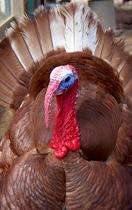Probing Question: What is a heritage turkey?

(PhysOrg.com) -- Over 45 million turkeys are eaten by Americans each Thanksgiving, according to the U.S. Department of Agriculture. Hunters provide some -- last autumn, about 24,000 wild turkeys were harvested in Pennsylvania. Vegetarians might serve up a soybean-based alternative, like Tofurky. However, most holiday tables feature a Broad-Breasted White, the breed that makes up over 99 percent of grocery-store turkeys. But with the trend in locally raised food, the "heritage turkey" is experiencing a surge in popularity.
R. Michael Hulet, associate professor of poultry science at Penn State, said many of these colorful birds (with equally colorful names such as Black Spanish, Bourbon Red, and Slate) are the commercially-bred turkeys of yesteryear.
"Some of these varieties were the progenitors of our current commercial turkeys, and they are fairly closely related to them genetically," he said. "Today's commercial turkeys are white because people didn't like the little dots of pigment left on the skin after the feathers are pulled out, so breeders selected for a white-skinned turkey."
The white color is more natural for chickens, Hulet said, "while it's a mutation for turkeys."
Unlike the heritage and wild breeds, commercial breeds such as the Broad-Breasted White can't fly or mate naturally, and are artificially inseminated.
"Commercial turkeys have undergone tremendous genetic selection for breast size and breast meat yield," said Hulet.
They also have been selected to grow quickly. While heritage turkeys may take 25 to 30 weeks to grow to 25-28 pounds, the commercial breeds become 40 pound birds within 18 weeks.
Heritage turkeys are a niche market, and "they are expensive to grow, because they don't produce as much meat per feed," said Hulet. "They allow local producers to diversify what they farm, and people say that, because they take longer to grow, there's a little more texture and 'turkey-ish' taste to the meat."
These "retro" turkeys have been around for a long time.
"Heritage birds were grown by people who raised them for fun, to show in fairs like the Farm Show in Pennsylvania," Hulet said. "Then the trend for buying local foods created a market for heritage turkey breeds, like the market we see for heritage tomatoes. Those types of birds can't supply all the demands we have in the U.S. for turkeys, though, especially this time of year."
Only about 15,000 heritage turkeys were raised in all of 2008, compared to the estimated 270 million commercial birds.
Whether a turkey is wild, commercial or heritage, they are all Meleagris Gallopavo, a species native to North America. Turkeys were domesticated in Mexico and taken to Europe by Spanish explorers in the 1500s, where they were selectively bred before being brought back to the Americas. The European breeds are the ancestors of both the Broad-Breasted White and the current heritage turkeys, which resulted from crossing European breeds with American wild turkeys.
What will be on Hulet's Thanksgiving table? "Turkey, definitely," he said.
While he doesn't worry about whether his bird is commercial, wild or heritage, "I do believe there is a texture and taste difference between a fresh and a frozen bird," he said. "We grow birds at Penn State, and students from the Poultry Science Club process them the week before Thanksgiving, and sell them to promote their activities. They're fresh, so I'll be eating one of those."
Provided by Penn State, Chris Tachibana

















